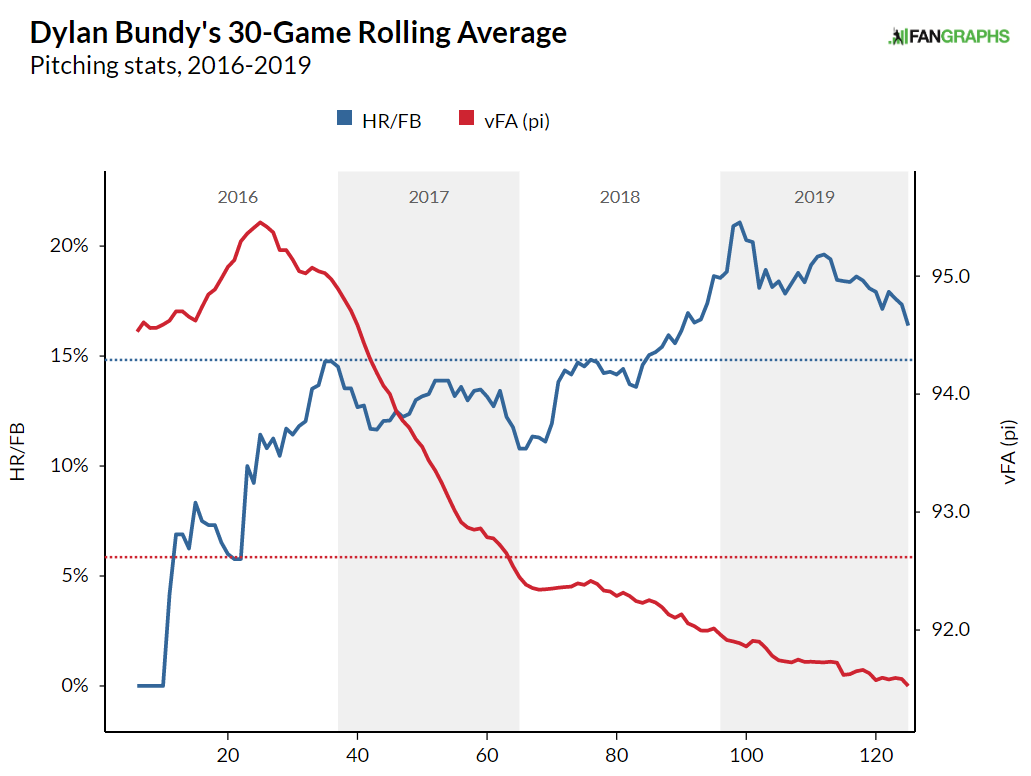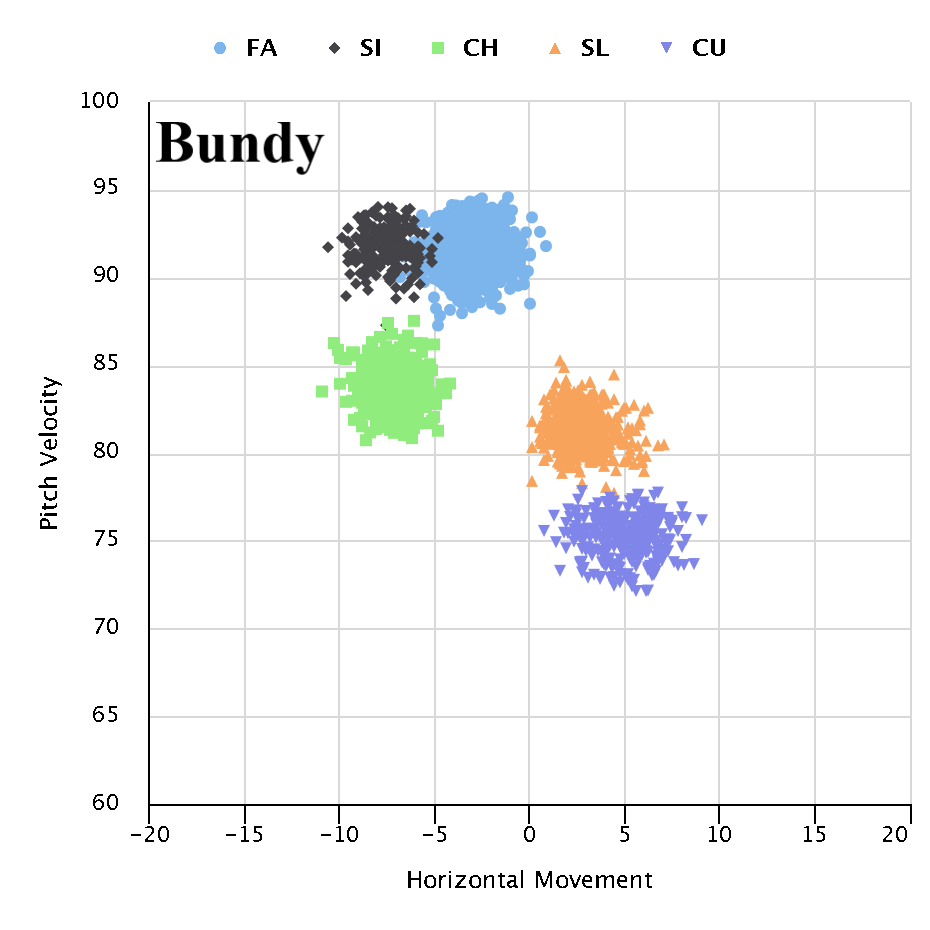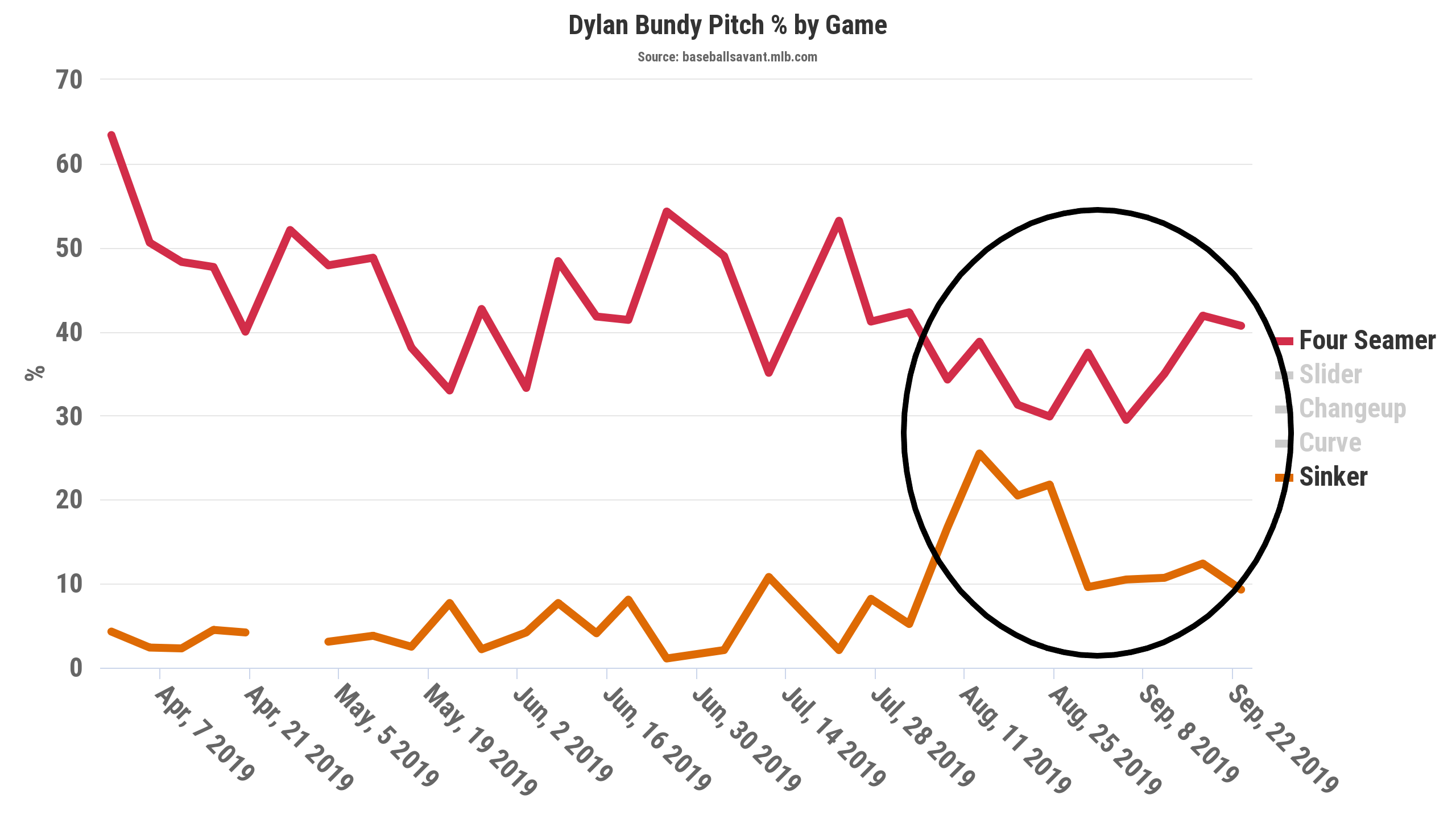The other day, it was reported that Dylan Bundy could be traded. It could happen any day now. We will likely see a contender with an incomplete rotation take a chance on him, or we could see a rebuilding (or “reimagining”, as Jerry Dipoto puts it) team like the Seattle Mariners acquire Bundy since he’s young, affordable, and his price is lower than ever. Worst-case scenario, the 27-year-old is probably a No. 5 starter who gives you some volume. The most favorable scenario, of course, is that Bundy is legitimately good.
For starters, Bundy hasn’t gotten a fair shake. Since 2017, he has the fifth-highest fly-ball percentage at 43.7%. Despite this, he also had a HR/FB of 15.1%, which was the 11th-highest number in the league out of 47 starters. That’s a number that you generally see out of ground-ball-heavy pitchers—there are a few reasons for this. First, he gives up hard contact. Duh. Since 2017, Bundy is in the 75th percentile in exit velocity on fly balls and line drives, at 93.0 mph. That’s not good!
But his home park is also Camden Yards. Dan Richards found that Camden Yards is the third-most extreme hitters park in Major League Baseball. Alex Chamberlain found that Camden Yards is quite hitter-friendly as well. Perhaps these three things (fly-ball tendencies, hard contact, and his home park) help explain both his .334 wOBA as well as his .320 xwOBA. Since 2017, his wOBA minus xwOBA of .014 is the seventh-highest in the league, which is in the 94th percentile of what I’ll call underperforming. Interestingly, from 2017 to 2019, he’s been about even at home (.338 wOBA) compared to what he’s pitched on the road (.332 wOBA). So it’s not all his home park (if at all).
It’s no secret that his biggest issue is his fastball, which used to have quite a bit of velocity.
Bundy’s 30-game rolling HR/FB and fastball velocity:

Mind you, in 2016, Bundy didn’t even have his slider, which is far and away his best pitch. Once his velocity declined, his fastball went out the window. This graph is somewhat misleading, as Bundy pitched in relief halfway into 2016, but he had velocity when he started that year that he doesn’t have today, which is (one half of) the point of this graph. Now that it seems all but clear that his fastball velocity isn’t coming back (unless he gets moved to the bullpen), it’s time for Bundy to pivot to something else.
Do you know who has a bad fastball? Patrick Corbin has a bad fastball. Both of his fastballs are only marginally better than Bundy’s. Unfortunately, Bundy’s average launch angle and fly-ball percentage are both significantly higher on his sinker than Corbin’s, but at this point, Bundy should take any improvements that he can get. If you can’t tell where I’m going with this, let’s look at what it would look like for Bundy to go full-on Corbin.
First off, the comparison isn’t completely unreasonable. By pitch movement:

Admittedly, it’s a little weird. Because Corbin is left-handed, the graphic is mirrored to the opposite side. Corbin himself is peculiar, as he varies the movement on his breaking and offspeed pitches, but overall their setup is similar. The hangup, of course, is mostly pitch mix.
Bundy and Corbin, by pitch mix:
| FF% | FT% | SL% | CU% | CH% | |
|---|---|---|---|---|---|
| Bundy | 42.4 | 7.5 | 22.8 | 9.9 | 17.4 |
| Corbin | 19.4 | 34.3 | 37.1 | 3.5 | 5.7 |
Bundy has options here. What we want to see is him optimizing his pitch mix—not just matching Corbin’s. That means that Bundy could (and should) throw his changeup more than Corbin does, and he can keep throwing his curveball, too. Mostly, what we want to see is Bundy get his slider usage over, say, 30%, and get his four-seam fastball down to at least 25%. He could certainly make more exaggerated changes, but it could look something like this, considering few pitchers throw breaking pitches as often as Corbin (although pitchers are starting to trend that way).
He might already be thinking of making this change. Bundy’s pitch mix in 2019, by game:

Bundy bumped his sinker usage up significantly for three games, and then for the rest of the year, it hovered around 10%, which he had only done in one game prior in 2019. This alone is encouraging, but the results were too.
First, let’s see how it affected his strikeouts and walks, as well as ground-ball and fly-ball tendencies:
| K-BB% | GB% | HR/9 | HR/FB | |
|---|---|---|---|---|
| Thru 8/9: | 15.9 | 37.5 | 1.89 | 17.9 |
| From 8/14: | 12.3 | 51.1 | 0.95 | 11.6 |
The strikeouts went down some, and the walks went up some. That’s not a good combination, but his HR/FB and HR/9 both came down to earth, and he started inducing a lot of ground balls. Right now, our top priority is to get Bundy’s home run numbers to come down from where they are, since they are so drastically bloated. This change seems to have achieved that, at least temporarily.
Next, let’s take a look at his ERA and ERA estimators:
| ERA- | FIP- | xFIP- | |
|---|---|---|---|
| Thru 8/9: | 107 | 106 | 102 |
| From 8/14: | 89 | 82 | 95 |
Across the board, this looks really good. The sample size isn’t huge, but this is more than a month of pitching (47.1 innings pitched), and there’s a substantive change that we can point to.
Lastly, I want to see how it affected how his pitches interacted. By pitch values:
| wFB/C | wSL/C | wCB/C | wCH/C | |
|---|---|---|---|---|
| Thru 8/9: | -1.76 | 0.99 | 0.31 | 0.57 |
| From 8/14: | -0.71 | 2.45 | -0.21 | 0.71 |
Although his curveball graded out worse than before, we see marked improvements in his fastballs (which includes both his four-seamer and sinker) as well as his slider—and this is with Bundy still throwing his four-seamer 30-40% of the time. I’m speculating here, but I think Bundy’s sinker, slider, and changeup could have a symbiotic relationship. In other words, I think they can all stand to help make one another better, with Bundy’s slider obviously doing the bulk of the legwork. If we see these kinds of changes with a subtle increase in sinkers and decrease in four-seamers, I’d be quite interested to see what a drastic increase in both sinkers and sliders (and thus a decrease in four-seamers) would do.
Assuming this isn’t true, and that the value of Bundy’s pitches all remain static even with a change in pitch mix, I decided to do a little experiment. Essentially, I took the pitch mix that I theorized Bundy could use for next year, took his xwOBA values for all of his pitches since 2017, and calculated what his xwOBA (and thus wOBA) could be from there. This is a really, really crude way of going about things, because changing pitch mix causes a domino effect. If it didn’t, Corbin would only throw his slider, and Luis Castillo would only throw a changeup.
Here’s how it looks:
| Four-seam | Sinker | Slider | Curveball | Changeup | |
|---|---|---|---|---|---|
| Pitch % | 25.0 | 20.0 | 30.0 | 10.0 | 15.0 |
| xwOBA | 0.379 | 0.386 | 0.191 | 0.283 | 0.328 |
| Pitch% * xwOBA | 0.09475 | 0.0772 | 0.0573 | 0.0283 | 0.0492 |
| Final xwOBA | 0.307 |
Again, this is a crude, patchwork way of going about finding his future xwOBA with a better pitch mix, but with a more balanced repertoire (and it’s not even close to Corbinian yet), Bundy becomes a touch better than league average (which was a .319 xwOBA in 2019). Theoretically, we could see Bundy’s slider get worse as he throws it more, but that’s not certain. We needn’t look further than Corbin to see that using a pitch more doesn’t mean it becomes less effective.
Of course, there’s a chance that none of this works. Jerad Eickhoff threw 61% breaking pitches this season and was still bad. I am neither the first to say Bundy should throw his slider more, nor the first to say he should throw his fastball less. There are an infinite amount of possibilities for what Bundy can do to be a better pitcher. There are several ways that this can all go wrong, but if he goes to the right team, I’m giddy to see what Bundy can do with a few tweaks. We could see the Bundy of old, we could see him develop into a Corbin, or if he moves to the bullpen, we could see him limit his repertoire, reach back for a few more ticks, and become something along the lines of Drew Pomeranz as a reliever. We’ve seen plenty of Dylan Bundy not at his best, but chances are, whoever his new team is should get more out of him than the Baltimore Orioles did.

